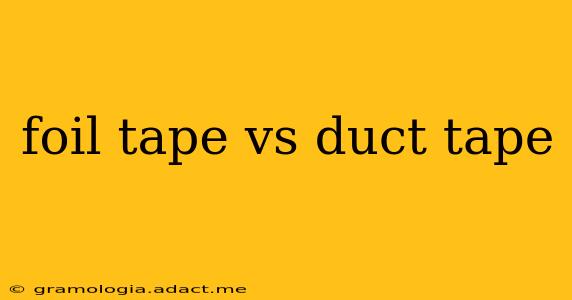Choosing between foil tape and duct tape often depends on the specific task at hand. While both are adhesive tapes used for a variety of purposes, their distinct properties make them better suited for different applications. This comprehensive guide will explore the key differences between foil tape and duct tape, helping you determine which is the right choice for your next project.
What is Foil Tape?
Foil tape is a type of pressure-sensitive adhesive tape with a metallic foil backing, typically aluminum. This gives it unique properties compared to duct tape, making it ideal for specific applications. The aluminum foil offers excellent reflectivity, resistance to moisture, and heat resistance. It's often used for sealing, insulating, and protecting surfaces.
What is Duct Tape?
Duct tape, also known as gaffer tape or duck tape, is a strong adhesive tape with a cloth backing. Its versatility stems from its robust adhesive and durable backing, making it suitable for a variety of temporary repairs and securing tasks. While it can handle some moisture, it's not as resistant as foil tape.
Foil Tape vs. Duct Tape: Key Differences
Here's a breakdown of the key differences to help you understand which tape best suits your needs:
Material:
- Foil Tape: Aluminum foil backing.
- Duct Tape: Cloth backing.
Adhesiveness:
- Foil Tape: Generally less aggressive adhesive than duct tape, designed for clean removal in many cases.
- Duct Tape: Strong, aggressive adhesive, often difficult to remove cleanly.
Durability:
- Foil Tape: Durable, particularly in terms of heat and moisture resistance.
- Duct Tape: Durable and strong for temporary repairs but can degrade with prolonged exposure to UV light and moisture.
Water Resistance:
- Foil Tape: Excellent water resistance due to the aluminum foil.
- Duct Tape: Offers some water resistance, but not as effective as foil tape.
Heat Resistance:
- Foil Tape: Good heat resistance, making it suitable for applications involving higher temperatures.
- Duct Tape: Limited heat resistance; high temperatures can cause the adhesive to melt or the tape to weaken.
Applications:
- Foil Tape: HVAC sealing, waterproofing, electrical insulation, heat shielding, crafting, and masking.
- Duct Tape: Temporary repairs, bundling, securing items, packaging, and many other general-purpose applications.
Which Tape is Right for My Project?
The best choice depends heavily on your specific needs. Consider these factors:
What material are you working with?
Foil tape is ideal for metal, glass, or other surfaces where its reflective and moisture-resistant properties are beneficial. Duct tape works well with a wider range of materials, including wood, plastic, and fabrics.
How long does the repair/seal need to last?
For long-term solutions, foil tape's durability, especially its heat and moisture resistance, might be preferable. Duct tape is better suited for temporary fixes.
What is the temperature range?
Foil tape can better withstand high temperatures. Duct tape is more prone to failure under heat.
Frequently Asked Questions (FAQs)
Can I use foil tape outdoors?
Yes, foil tape is excellent for outdoor use, especially in applications requiring moisture and UV resistance.
Can I use duct tape outdoors?
While duct tape can be used outdoors temporarily, it's not ideal for long-term exposure to sunlight and moisture as it will eventually degrade.
Is foil tape conductive?
Aluminum foil is a conductor of electricity. Exercise caution when using foil tape near electrical components. Ensure proper insulation is maintained.
Is duct tape conductive?
Duct tape is generally considered non-conductive. However, it's not designed for electrical insulation.
Which tape is easier to remove?
Foil tape is generally easier to remove cleanly than duct tape, especially from smooth surfaces. Duct tape's strong adhesive often leaves residue.
This detailed comparison should help you choose between foil tape and duct tape for your specific needs. Remember to always consider the specific application and the properties of each tape to ensure optimal results.
